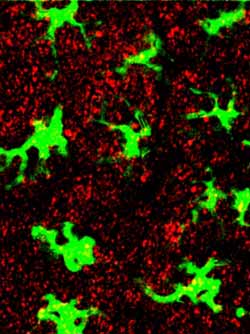Nano-sized vaccines

Immune cells, tagged with green fluorescent protein, are surrounded by nanoparticles (red), after the nanoparticles are injected into the skin of a mouse. Photo: Peter DeMuth and James Moon<br>
MIT engineers have designed a new type of nanoparticle that could safely and effectively deliver vaccines for diseases such as HIV and malaria.
The new particles, described in the Feb. 20 issue of Nature Materials, consist of concentric fatty spheres that can carry synthetic versions of proteins normally produced by viruses. These synthetic particles elicit a strong immune response — comparable to that produced by live virus vaccines — but should be much safer, says Darrell Irvine, author of the paper and an associate professor of materials science and engineering and biological engineering.
Such particles could help scientists develop vaccines against cancer as well as infectious diseases. In collaboration with scientists at the Walter Reed Army Institute of Research, Irvine and his students are now testing the nanoparticles’ ability to deliver an experimental malaria vaccine in mice.
Vaccines protect the body by exposing it to an infectious agent that primes the immune system to respond quickly when it encounters the pathogen again. In many cases, such as with the polio and smallpox vaccines, a dead or disabled form of the virus is used. Other vaccines, such as the diphtheria vaccine, consist of a synthetic version of a protein or other molecule normally made by the pathogen.
When designing a vaccine, scientists try to provoke at least one of the human body’s two major players in the immune response: T cells, which attack body cells that have been infected with a pathogen; or B cells, which secrete antibodies that target viruses or bacteria present in the blood and other body fluids.
For diseases in which the pathogen tends to stay inside cells, such as HIV, a strong response from a type of T cell known as “killer” T cell is required. The best way to provoke these cells into action is to use a killed or disabled virus, but that cannot be done with HIV because it’s difficult to render the virus harmless.
To get around the danger of using live viruses, scientists are working on synthetic vaccines for HIV and other viral infections such as hepatitis B. However, these vaccines, while safer, do not elicit a very strong T cell response. Recently, scientists have tried encasing the vaccines in fatty droplets called liposomes, which could help promote T cell responses by packaging the protein in a virus-like particle. However, these liposomes have poor stability in blood and body fluids.
Irvine, who is a member of MIT’s David H. Koch Institute for Integrative Cancer Research, decided to build on the liposome approach by packaging many of the droplets together in concentric spheres. Once the liposomes are fused together, adjacent liposome walls are chemically “stapled” to each other, making the structure more stable and less likely to break down too quickly following injection. However, once the nanoparticles are absorbed by a cell, they degrade quickly, releasing the vaccine and provoking a T cell response.
In tests with mice, Irvine and his colleagues used the nanoparticles to deliver a protein called ovalbumin, an egg-white protein commonly used in immunology studies because biochemical tools are available to track the immune response to this molecule. They found that three immunizations of low doses of the vaccine produced a strong T cell response — after immunization, up to 30 percent of all killer T cells in the mice were specific to the vaccine protein.
That is one of the strongest T cell responses generated by a protein vaccine, and comparable to strong viral vaccines, but without the safety concerns of live viruses, says Irvine. Importantly, the particles also elicit a strong antibody response. Niren Murthy, associate professor at Georgia Institute of Technology, says the new particles represent “a fairly large advance,” though he says that more experiments are needed to show that they can elicit an immune response against human disease, in human subjects. “There’s definitely enough potential to be worth exploring it with more sophisticated and expensive experiments,” he says.
In addition to the malaria studies with scientists at Walter Reed, Irvine is also working on developing the nanoparticles to deliver cancer vaccines and HIV vaccines. Translation of this approach to HIV is being done in collaboration with colleagues at the Ragon Institute of MIT, Harvard and Massachusetts General Hospital. The institute, which funded this study along with the Gates Foundation, Department of Defense and National Institutes of Health, was established in 2009 with the goal of developing an HIV vaccine.
Media Contact
More Information:
http://www.mit.eduAll latest news from the category: Materials Sciences
Materials management deals with the research, development, manufacturing and processing of raw and industrial materials. Key aspects here are biological and medical issues, which play an increasingly important role in this field.
innovations-report offers in-depth articles related to the development and application of materials and the structure and properties of new materials.
Newest articles

Going Steady—Study Reveals North Atlantic’s Gulf Stream Remains Robust
A study by the University of Bern and the Woods Hole Oceanographic Institution in the USA concludes that the ocean circulation in the North Atlantic, which includes the Gulf Stream,…

Single-Celled Heroes: Foraminifera’s Power to Combat Ocean Phosphate Pollution
So-called foraminifera are found in all the world’s oceans. Now an international study led by the University of Hamburg has shown that the microorganisms, most of which bear shells, absorb…

Humans vs Machines—Who’s Better at Recognizing Speech?
Are humans or machines better at recognizing speech? A new study shows that in noisy conditions, current automatic speech recognition (ASR) systems achieve remarkable accuracy and sometimes even surpass human…



